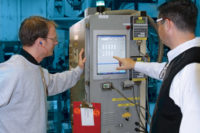NEW YORK — Merger and acquisition activity in the industrial manufacturing industry showed continued strength in the third quarter of 2015, with more than 50 deals worth more than $50 million for the sixth quarter in a row, according to Assembling Value, a quarterly analysis of global deal activity in the industrial manufacturing industry by PwC US.
While growing uncertainty about the future prospects for the global economy has created serious underlying fears about the years ahead, manufacturing executives continue to re-evaluate their business portfolios, add scale to better leverage core capabilities, and divest or spin-off non-core operations.
According to PwC, there were 55 transactions (worth more than $50 million) in the third quarter for a total deal value of $20.9 billion. Both value and volume declined from the previous quarter which recorded 66 deals totaling $28.2 billion. However, deal activity year-to-date remained healthy with 180 deals raising $69.6 billion. Four mega-deals (transactions worth more than $1 billion) were announced for a total deal value of $9.8 billion or 47 percent of the quarter’s total deal value.
“The continued interest in deal making in the third quarter has been especially notable given weakening global manufacturing activity and increased uncertainty regarding the economic outlook,” said Bobby Bono, U.S. industrial manufacturing leader for PwC. “Manufacturing executives in our latest Manufacturing Barometer reported a drop in optimism towards the world economy’s prospects as the economic slowdown in China, along with weak global demand and a strong dollar, continued to weigh heavily on the growth of the manufacturing sector. As we enter the final quarter of the year, we expect the level of deal activity to remain stable as mixed global economic results steer manufacturing executives toward further portfolio reshuffling.”
Similar to previous quarters, strategic buyers continued to align product portfolios with high-growth markets, such as automotive, aerospace, and electric through acquisitions. Strategic investors represented 66 percent of deal activity in the quarter. With plenty of cash at their disposal, both strategic and financial buyers have been active in deals involving diverse end markets, particularly in Asia and areas of Europe on the verge of recovery.
Bono added: “Strategic acquirers remain concerned about the broad economic environment and are taking a cautious approach to their deal strategies. While they continue to execute on sizable transactions, they are continuously evaluating their portfolios and taking advantage of opportunities to divest non-core assets. Divestitures continue to be a viable exit option, representing 27 percent of deal activity this quarter.”
On a regional basis, the U.S. share of global activity remained among its lowest levels in a decade as local activity in Asia continued to dominate deal making. Acquirers from Asia and Oceania accounted for 62 percent of total deal activity in the quarter, while targets in the region represented 56 percent of all deals. The majority (75 percent) of deals in the third quarter were local market deals; however, the strength of the dollar could lead to an increase in U.S. outbound deals in the coming months.
PwC’s industrial manufacturing M&A analysis is a quarterly report of announced global transactions with value greater than $50 million analyzed by PwC using transaction data from Thomson Reuters.
For more information on PwC’s Deals practice, visit www.pwc.com/us/deals.







